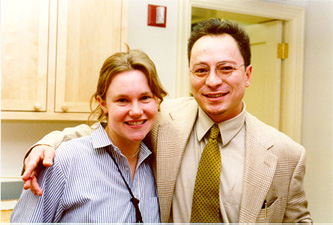
 |
| The irovy tower ain't what it used to be. |
format: Send your papers to papers@writing.upenn.edu with no formatting. Unformatted text sent by email is sometimes called "plain text" or "ascii." If all else fails, simply block and copy your paper's text from the word processor you are using, and send the copied block by email to us.
 position papers consist of 60 to 75
e-mail lines
position papers consist of 60 to 75
e-mail lines
 position papers don't fiddle-faddle with
general introductions or
conclusions,
position papers don't fiddle-faddle with
general introductions or
conclusions,
 |
| Shawn Walker (English 88v teaching assistant) at left; Dave Deifer (founder and editor of CrossConnect and founding member of the Writers House planning committee) at right |
 position papers don't summarize what's
in the text (assume your reader knows the text
well), and be sure to
position papers don't summarize what's
in the text (assume your reader knows the text
well), and be sure to
 a good rule of thumb
a good rule of thumb